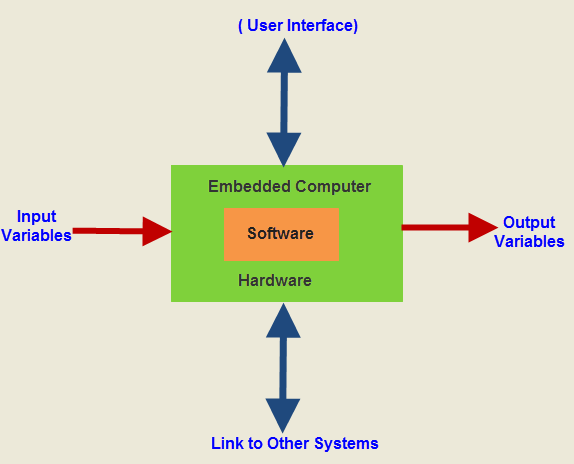Definition
“Embedded system is a system that has embedded software and electronics hardware, which makes it a system dedicated for an application(s) or specific part of an application (large system).”
Ex. ATM, Washing Machine.
An embedded system is, basically, a computer controlled device designed to perform specific tasks. In most cases, these tasks help resolve the real-time control of machines or processes. Embedded systems are cheaper than general purpose system, such as PCs.

Embedded System Characteristics
Typical functions of embedded systems can be the following:
- Processing: ability to process the analog /digital signals.
- Communication: ability to transfer signals (“Information”) from/to the outside world.
- Storage: the ability to preserve the temporary information within the embedded system.
- Each specific application made by an embedded system has different requirements for processing, power supply, storage and communication.
- A same functionality (e.g., the ability to acquire still images via a CCD sensor) can be optimized radically in different way when applied, for example, a digital camera or a cell phone or a digital camcorder.
Hardware and software characteristics of embedded systems can be described in the following points:
- Communication interfaces: typically the sale price of an embedded system is low, the choice of communication interfaces is critical because it greatly affects the final price of the product.
- User Interface: In many embedded systems the user interface consists of a few buttons and/or LEDs; in others, it uses the user interface of a host system.
- Power management: is a crucial factor to be considered for all embedded systems are powered by batteries.
- Dimensions and weight: in many cases, the physical characteristics are another critical factor; usually the embedded system must be small, very light or with a particular form (for example, very thin).
- Quality of service: many applications of embedded systems have stringent requirements in terms of QoS (Quality of Service); as a particular case, many applications require the provision of services in real time with stringent timing constraints.
- Code size: the storage capacity of embedded systems is limited, so the size of the internal program (e.g. firmware) is an important factor.
- Numeracy/Communication skills/Storage: commensurate to the specific application performed by the embedded system.
- Updating the program: it is useful to include the ability to update the programs in embedded systems so as to correct errors discovered after the production and introduce new features.
In addition to the parameters involved in the market, the hardware, software features and embedded systems are used to be dependable. Actually, in the design phase is necessary to consider the following aspects:
- Reliability: realistic assessment of the probability that the system fails.
- Maintainability: the system can be repaired or replaced within a certain time interval.
- Availability: probability that the system is working; essentially depends on the reliability and maintainability.
- Safety: properties related to the possibility that in the event of system failure are caused damages to people or things.
- Security: resilience of the system against unauthorized use.
Example of an Embedded System
In order to explain what embedded system is, it’s easy to describe an everyday product that become and embedded system. For this let’s choose room temperature controller. Below are the purpose, input, output, signals and a sequence of activity or the set of rules for these machines are given:
| Purpose | To control the room temperature at some degree temperature. |
| Inputs | 1. Start and Stop.
2. User command for temperaturevia Keyboard or variable register (POT). 3. Temperature via sensor. |
| Signals, Events and Notifications | 1. Change in reference via POT.
2. Temperature variation using sensor. |
| Output | 1. Power on LED.
2. Control signal for RELAY. |
| Set of rules | 1. Once power is on first calculate the reference temperature according to POT and determine the lower and upper limit.
2. Sense the temperature of room using sensor. 3. If temperature is lesser thanlower limitthen turn on relay. And keep it on till temperature reaches higher value. 4. If temperature is higher than lower limit then turn off relay. And keep it off till temperature reaches higher value. |